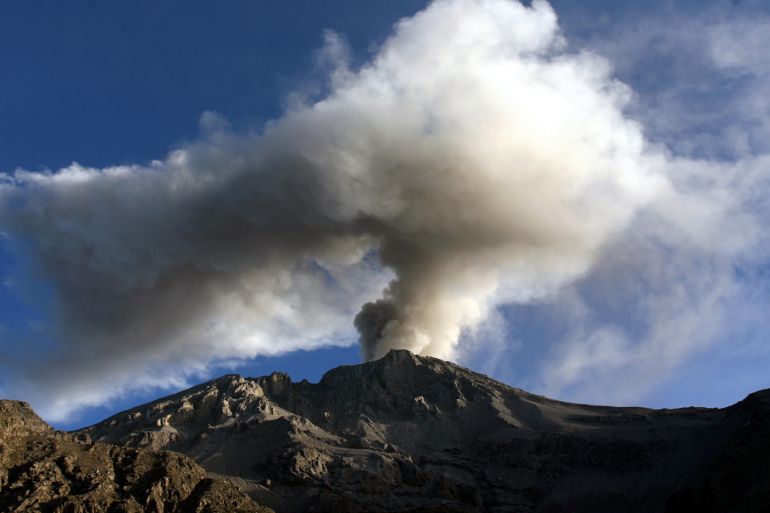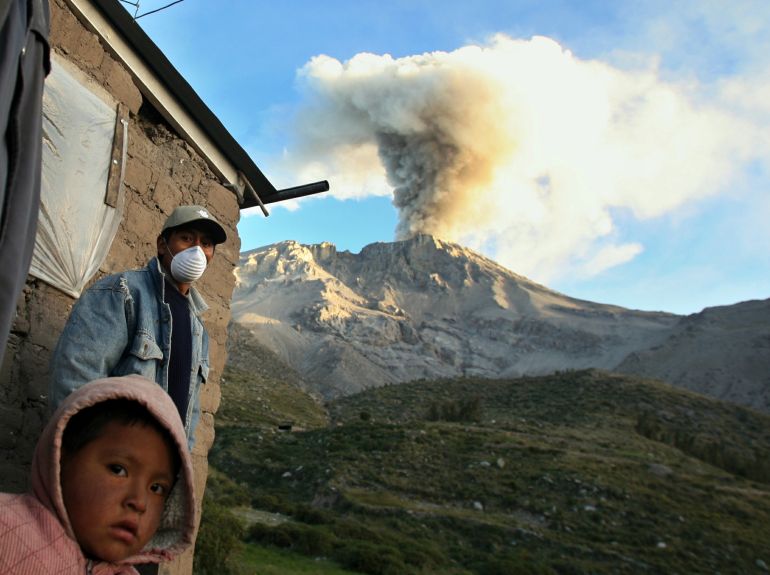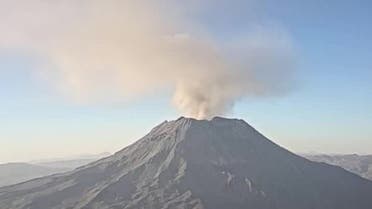Ubinas volcano set to trigger state of emergency in Peru
Previous eruptions from Peru’s most active volcano triggered mudslides and ash clouds responsible for killing livestock.

Previous eruptions from Peru’s most active volcano triggered mudslides and ash clouds responsible for killing livestock.

In the wake of a 2006 eruption, local officials blamed the Ubinas volcano for causing widespread respiratory problems and killing llamas that ate grass dusted with toxic emissions [Reuters]
Published On 4 Jul 2023
Officials in the Peruvian government have announced they will declare a state of emergency for the area surrounding the Ubinas volcano, after persistent seismic activity shook the region and sent a column of toxic gas into the air.
Alberto Otárola, the president of Peru’s Council of Ministers, announced on Monday that the emergency declaration was anticipated for the southern department of Moquegua, where the volcano is located.
“We are taking charge of these phenomena, and we are always proactively coordinating with all institutions to face them,” he said.
The emergency order will allow the government to take “the measures necessary” to prevent health risks, Otárola explained. Already, masks are being distributed as ash fills the air.
SOURCE: AL JAZEERA
Officials in the Peruvian government have announced they will declare a state of emergency for the area surrounding the Ubinas volcano, after persistent seismic activity shook the region and sent a column of toxic gas into the air.
Alberto Otárola, the president of Peru’s Council of Ministers, announced on Monday that the emergency declaration was anticipated for the southern department of Moquegua, where the volcano is located.
“We are taking charge of these phenomena, and we are always proactively coordinating with all institutions to face them,” he said.
The emergency order will allow the government to take “the measures necessary” to prevent health risks, Otárola explained. Already, masks are being distributed as ash fills the air.

A calf is outfitted with a mask in the wake of a 2006 eruption of the Ubinas volcano [Reuters]
Some 2,000 people stand to be affected in the immediate area, Otárola said. He urged the population to remain calm.
Moguegua’s regional government raised the alert level on Sunday from yellow to orange, to indicate heightened danger from the volcano.
Ubinas is the most active volcano in the country, forming part of the “Ring of Fire”, an area of seismic activity that surrounds the tectonic plate underneath the Pacific Ocean.
The current eruption began around June 22, according to the Geophysics Institute of Peru (IGP).
Some 2,000 people stand to be affected in the immediate area, Otárola said. He urged the population to remain calm.
Moguegua’s regional government raised the alert level on Sunday from yellow to orange, to indicate heightened danger from the volcano.
Ubinas is the most active volcano in the country, forming part of the “Ring of Fire”, an area of seismic activity that surrounds the tectonic plate underneath the Pacific Ocean.
The current eruption began around June 22, according to the Geophysics Institute of Peru (IGP).

The Ubinas volcano is located some 990 kilometres (550 miles) south of the Peruvian capital Lima [Reuters]
The institute recorded 402 earthquakes associated with the volcano between June 23 and 25. During that period of activity, a plume of ash rose nearly 1,300 metres (4,265 feet) above the volcano’s peak.
The National Civil Defence Institute has since advised residents to wear face masks and protect their eyes from the ash as well as create an evacuation plan for use if necessary.
The last large eruption at Ubinas came in 2019, resulting in thousands of people being displaced. While Ubinas has been erupting regularly since 1550, one of the most dramatic incidents came in 2006 after several decades of relative dormancy.
That eruption blanketed the region with ash, prompting evacuations and killing livestock with its toxic emissions.
The institute recorded 402 earthquakes associated with the volcano between June 23 and 25. During that period of activity, a plume of ash rose nearly 1,300 metres (4,265 feet) above the volcano’s peak.
The National Civil Defence Institute has since advised residents to wear face masks and protect their eyes from the ash as well as create an evacuation plan for use if necessary.
The last large eruption at Ubinas came in 2019, resulting in thousands of people being displaced. While Ubinas has been erupting regularly since 1550, one of the most dramatic incidents came in 2006 after several decades of relative dormancy.
That eruption blanketed the region with ash, prompting evacuations and killing livestock with its toxic emissions.
SOURCE: AL JAZEERA

Ubinas volcano volcanic activity Moquegua region, Peru on July 2, 2023.
(Reuters)
Reuters
Published: 03 July ,2023:
Peru will declare emergency status in the area around the Ubinas volcano in the southern region of Moquegua, the prime minister said on Monday, as the country’s most active volcano has been spewing ash for several days.
The National Institute of Civil Defense (INDECI) said in a statement that the area’s status alert has been raised to “orange” from yellow according to national standards after the volcano showed ash spill that reached 1,700 meters in height.
Southern Peru, an area where there are important mining sites, is home to a dozen active volcanoes. Peru is also in the so-called Pacific “Ring of Fire,” an area with a high incidence of earthquakes and volcanic activity.
Prime Minister Alberto Otarola told reporters at the Government Palace that the emergency status will probably be declared in the next few days in order to provide “the necessary prevention measures” for the region.
INDECI advised the region’s 2,000-strong population to stay away from the volcano and keep doors and windows closed.
Masks and glasses were delivered to the population, authorities added.
Peruvian authorities in 2019 evacuated hundreds of people living near the Ubinas volcano after explosions and ashes emissions.
Reuters
Published: 03 July ,2023:
Peru will declare emergency status in the area around the Ubinas volcano in the southern region of Moquegua, the prime minister said on Monday, as the country’s most active volcano has been spewing ash for several days.
The National Institute of Civil Defense (INDECI) said in a statement that the area’s status alert has been raised to “orange” from yellow according to national standards after the volcano showed ash spill that reached 1,700 meters in height.
Southern Peru, an area where there are important mining sites, is home to a dozen active volcanoes. Peru is also in the so-called Pacific “Ring of Fire,” an area with a high incidence of earthquakes and volcanic activity.
Prime Minister Alberto Otarola told reporters at the Government Palace that the emergency status will probably be declared in the next few days in order to provide “the necessary prevention measures” for the region.
INDECI advised the region’s 2,000-strong population to stay away from the volcano and keep doors and windows closed.
Masks and glasses were delivered to the population, authorities added.
Peruvian authorities in 2019 evacuated hundreds of people living near the Ubinas volcano after explosions and ashes emissions.
No comments:
Post a Comment